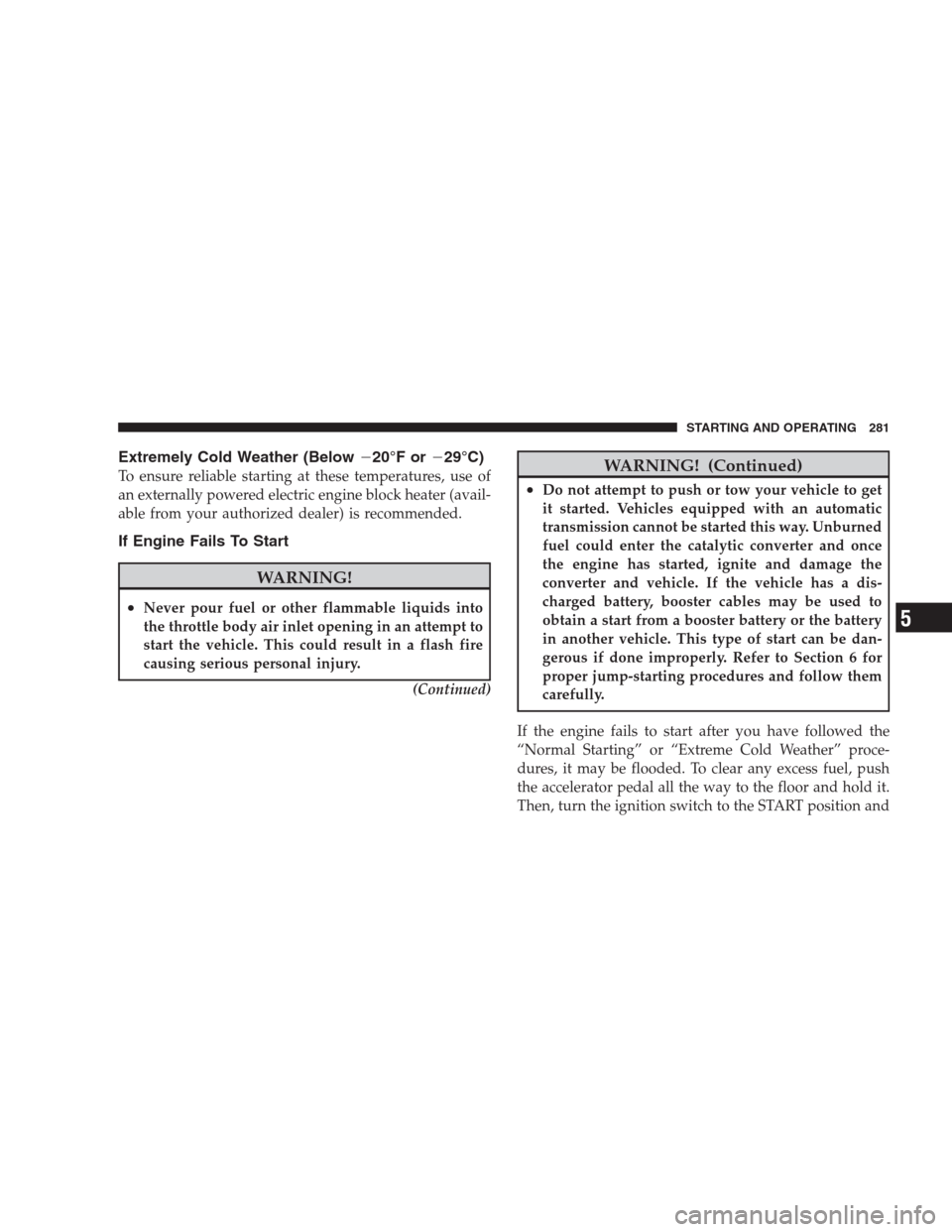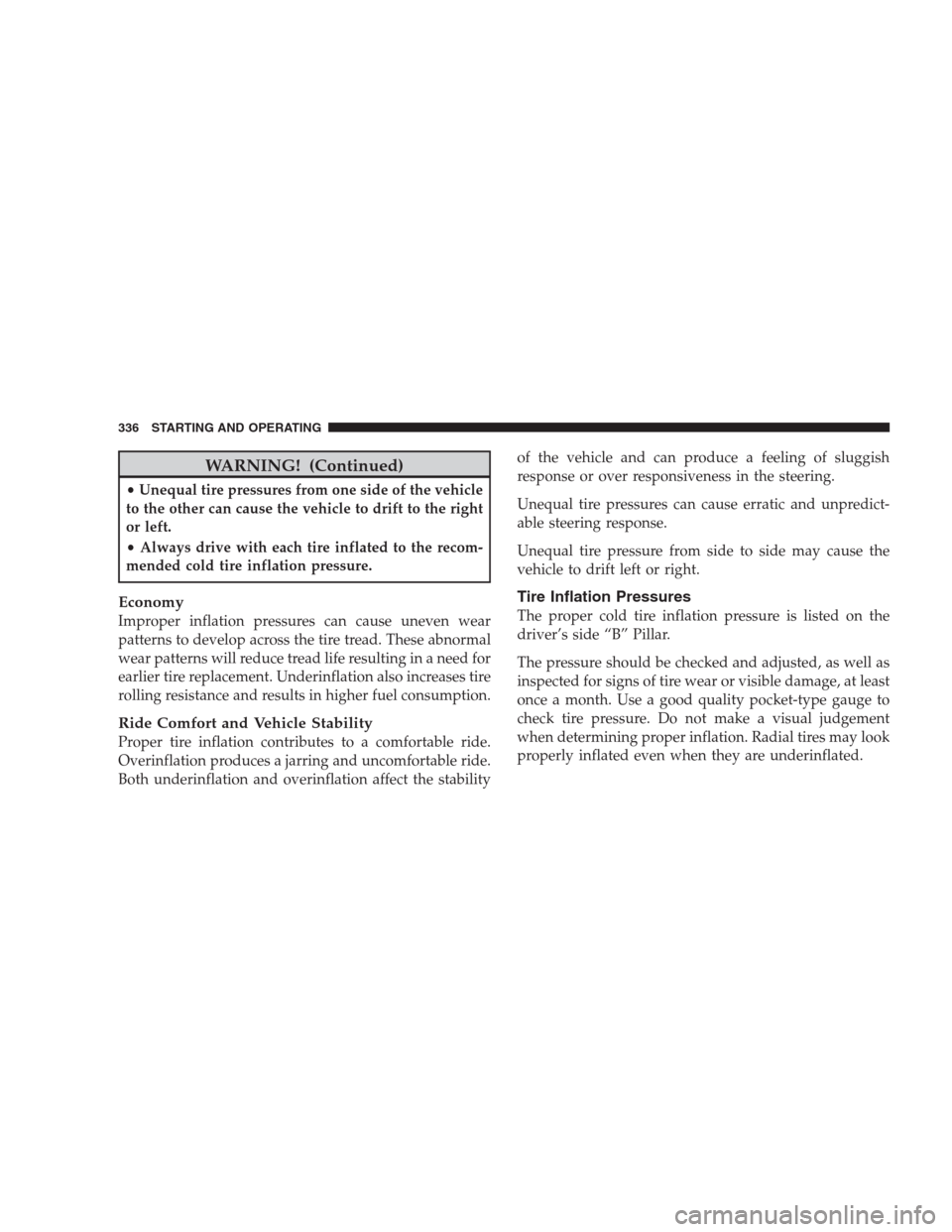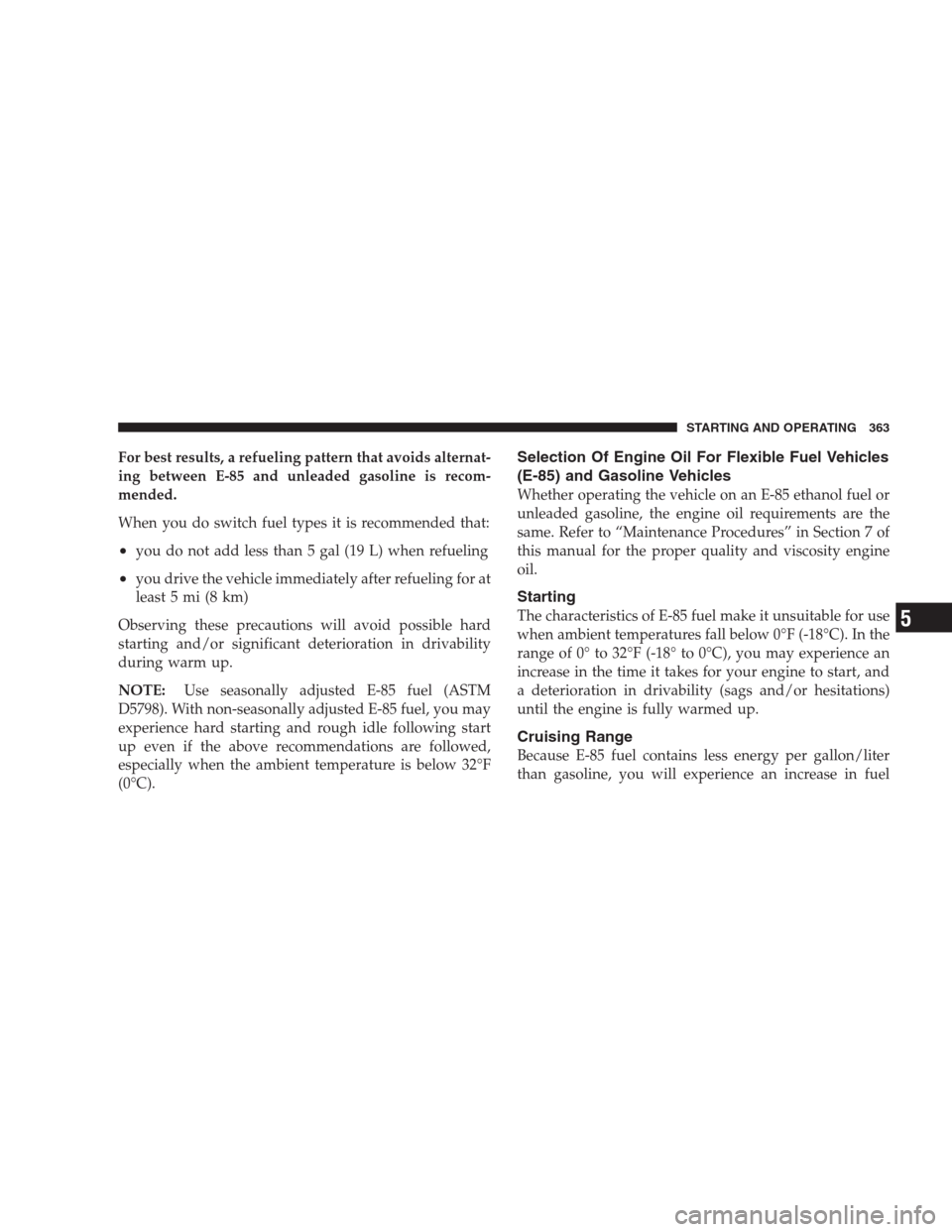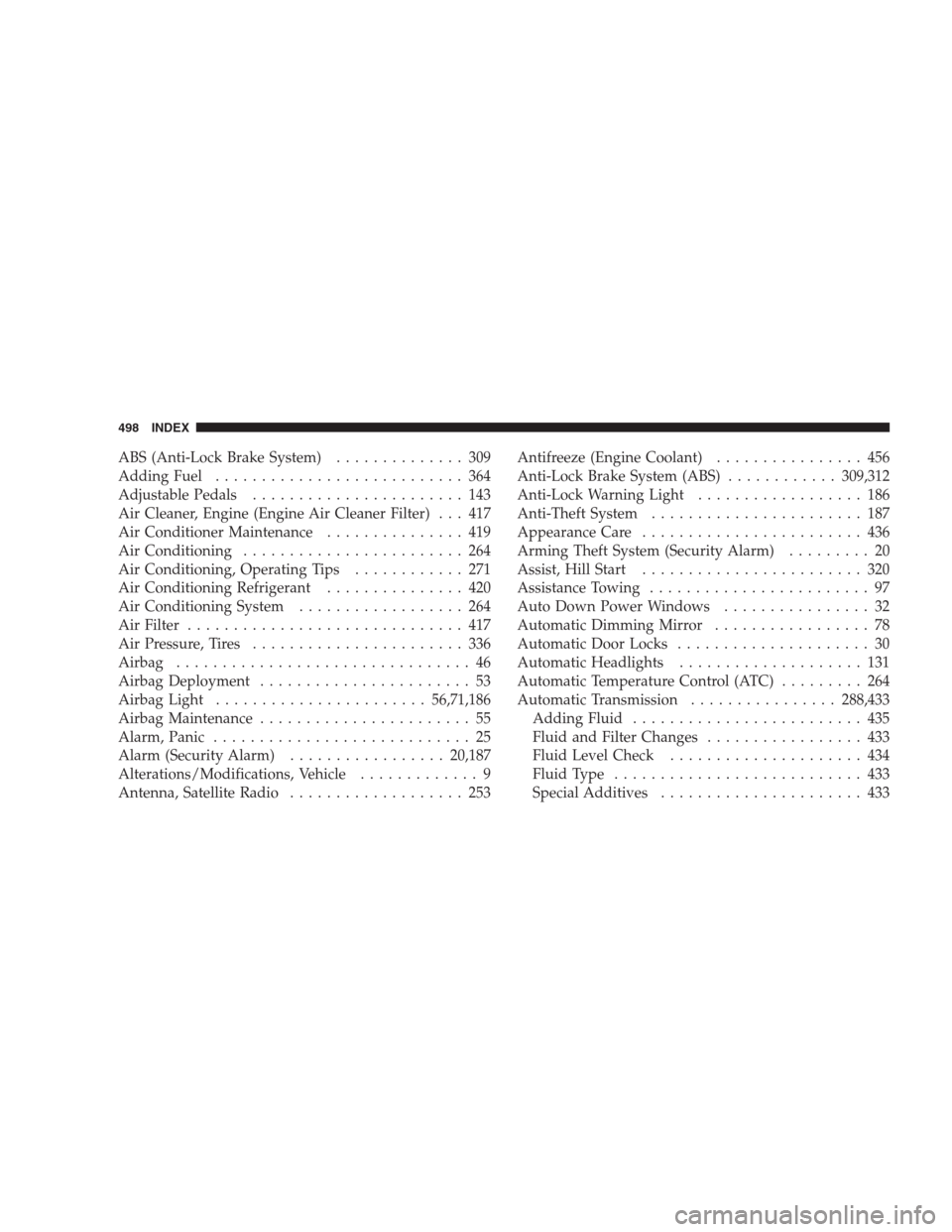Page 283 of 521

Extremely Cold Weather (Below�20°F or�29°C)
To ensure reliable starting at these temperatures, use of
an externally powered electric engine block heater (avail-
able from your authorized dealer) is recommended.
If Engine Fails To Start
WARNING!
•Never pour fuel or other flammable liquids into
the throttle body air inlet opening in an attempt to
start the vehicle. This could result in a flash fire
causing serious personal injury.
(Continued)
WARNING! (Continued)
•Do not attempt to push or tow your vehicle to get
it started. Vehicles equipped with an automatic
transmission cannot be started this way. Unburned
fuel could enter the catalytic converter and once
the engine has started, ignite and damage the
converter and vehicle. If the vehicle has a dis-
charged battery, booster cables may be used to
obtain a start from a booster battery or the battery
in another vehicle. This type of start can be dan-
gerous if done improperly. Refer to Section 6 for
proper jump-starting procedures and follow them
carefully.
If the engine fails to start after you have followed the
“Normal Starting” or “Extreme Cold Weather” proce-
dures, it may be flooded. To clear any excess fuel, push
the accelerator pedal all the way to the floor and hold it.
Then, turn the ignition switch to the START position and
STARTING AND OPERATING 281
5
Page 338 of 521

WARNING! (Continued)
•Unequal tire pressures from one side of the vehicle
to the other can cause the vehicle to drift to the right
or left.
•Always drive with each tire inflated to the recom-
mended cold tire inflation pressure.
Economy
Improper inflation pressures can cause uneven wear
patterns to develop across the tire tread. These abnormal
wear patterns will reduce tread life resulting in a need for
earlier tire replacement. Underinflation also increases tire
rolling resistance and results in higher fuel consumption.
Ride Comfort and Vehicle Stability
Proper tire inflation contributes to a comfortable ride.
Overinflation produces a jarring and uncomfortable ride.
Both underinflation and overinflation affect the stabilityof the vehicle and can produce a feeling of sluggish
response or over responsiveness in the steering.
Unequal tire pressures can cause erratic and unpredict-
able steering response.
Unequal tire pressure from side to side may cause the
vehicle to drift left or right.
Tire Inflation Pressures
The proper cold tire inflation pressure is listed on the
driver’s side “B” Pillar.
The pressure should be checked and adjusted, as well as
inspected for signs of tire wear or visible damage, at least
once a month. Use a good quality pocket-type gauge to
check tire pressure. Do not make a visual judgement
when determining proper inflation. Radial tires may look
properly inflated even when they are underinflated.
336 STARTING AND OPERATING
Page 365 of 521

For best results, a refueling pattern that avoids alternat-
ing between E-85 and unleaded gasoline is recom-
mended.
When you do switch fuel types it is recommended that:
•you do not add less than 5 gal (19 L) when refueling
•you drive the vehicle immediately after refueling for at
least 5 mi (8 km)
Observing these precautions will avoid possible hard
starting and/or significant deterioration in drivability
during warm up.
NOTE:Use seasonally adjusted E-85 fuel (ASTM
D5798). With non-seasonally adjusted E-85 fuel, you may
experience hard starting and rough idle following start
up even if the above recommendations are followed,
especially when the ambient temperature is below 32°F
(0°C).
Selection Of Engine Oil For Flexible Fuel Vehicles
(E-85) and Gasoline Vehicles
Whether operating the vehicle on an E-85 ethanol fuel or
unleaded gasoline, the engine oil requirements are the
same. Refer to “Maintenance Procedures” in Section 7 of
this manual for the proper quality and viscosity engine
oil.
Starting
The characteristics of E-85 fuel make it unsuitable for use
when ambient temperatures fall below 0°F (-18°C). In the
range of 0° to 32°F (-18° to 0°C), you may experience an
increase in the time it takes for your engine to start, and
a deterioration in drivability (sags and/or hesitations)
until the engine is fully warmed up.
Cruising Range
Because E-85 fuel contains less energy per gallon/liter
than gasoline, you will experience an increase in fuel
STARTING AND OPERATING 363
5
Page 500 of 521

ABS (Anti-Lock Brake System).............. 309
Adding Fuel........................... 364
Adjustable Pedals....................... 143
Air Cleaner, Engine (Engine Air Cleaner Filter) . . . 417
Air Conditioner Maintenance............... 419
Air Conditioning........................ 264
Air Conditioning, Operating Tips............ 271
Air Conditioning Refrigerant............... 420
Air Conditioning System.................. 264
Air Filter.............................. 417
Air Pressure, Tires....................... 336
Airbag................................ 46
Airbag Deployment....................... 53
Airbag Light.......................56,71,186
Airbag Maintenance....................... 55
Alarm, Panic............................ 25
Alarm (Security Alarm).................20,187
Alterations/Modifications, Vehicle............. 9
Antenna, Satellite Radio................... 253Antifreeze (Engine Coolant)................ 456
Anti-Lock Brake System (ABS)............309,312
Anti-Lock Warning Light.................. 186
Anti-Theft System....................... 187
Appearance Care........................ 436
Arming Theft System (Security Alarm)......... 20
Assist, Hill Start........................ 320
Assistance Towing........................ 97
Auto Down Power Windows................ 32
Automatic Dimming Mirror................. 78
Automatic Door Locks..................... 30
Automatic Headlights.................... 131
Automatic Temperature Control (ATC)......... 264
Automatic Transmission................288,433
Adding Fluid......................... 435
Fluid and Filter Changes................. 433
Fluid Level Check..................... 434
Fluid Type........................... 433
Special Additives...................... 433
498 INDEX